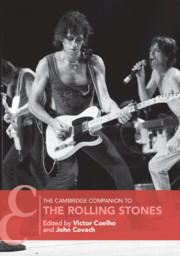Book contents
- The Cambridge Companion to the Rolling Stones
- Cambridge Companions to Music
- The Cambridge Companion to the Rolling Stones
- Copyright page
- Dedication
- Contents
- Illustrations
- Tables
- Notes on Contributors
- Preface
- Abbreviations
- Part I Albums, Songs, Players, and the Core Repertory of the Rolling Stones
- Part II Sound, Roots, and Brian Jones
- 6 The Rolling Stones’ Sound: At the Crossroads of Roots and Technology
- 7 Driving Stones Country in Five Songs
- 8 A “Gust of Fresh Air”: Brian Jones, Assemblage, and World Music
- Part III Stones on Film, Revival, and Fans
- Bibliography
- Index of Songs, Albums, and Visual Media Cited in the Text
- General Index
7 - Driving Stones Country in Five Songs
from Part II - Sound, Roots, and Brian Jones
Published online by Cambridge University Press: 23 August 2019
- The Cambridge Companion to the Rolling Stones
- Cambridge Companions to Music
- The Cambridge Companion to the Rolling Stones
- Copyright page
- Dedication
- Contents
- Illustrations
- Tables
- Notes on Contributors
- Preface
- Abbreviations
- Part I Albums, Songs, Players, and the Core Repertory of the Rolling Stones
- Part II Sound, Roots, and Brian Jones
- 6 The Rolling Stones’ Sound: At the Crossroads of Roots and Technology
- 7 Driving Stones Country in Five Songs
- 8 A “Gust of Fresh Air”: Brian Jones, Assemblage, and World Music
- Part III Stones on Film, Revival, and Fans
- Bibliography
- Index of Songs, Albums, and Visual Media Cited in the Text
- General Index
Summary
Fashioning identity has always been at the heart of the Rolling Stones’ music and mystique. From their origins as white English teenagers delving as deeply into black American rhythm and blues as any band in Britain (or the States, for that matter) at the time, to their post-sixties forays into glam rock, reggae, disco, and other diversions, they rode into the twenty-first century as a self-defining “classic,” parlaying their status as one of the most accomplished and longest-lasting bands of the rock era into a self-sustaining mega act. Through it all, the initial connection to the blues remains the stylistic marker to which they are most often associated, an influence that has come full circle with their recent Grammy Award-winning album of blues covers, Blue and Lonesome of 2016. As they came to public attention, the overtly African-American implications of the blues provided the Stones with an edgy cultural distinction. To be sure, other British invaders built their sound on a foundation of blues artists from the 1930s through the early 1960s, but as the Stones rose to prominence among such acts, they were drawn into a binary relationship with the Beatles, whose style was more obviously eclectic and whose identity was driven by the commercial agenda of their manager Brian Epstein. This proved especially true in the States when each group arrived for tours in 1964. It is no surprise, for example, that when the Beatles had a few days off on their initial visit to the USA in February, 1964, they remained in Miami (where they made their second appearance on the Ed Sullivan Show) to take in nightclub acts at the Deauville Hotel or fishing and riding speed boats around Miami harbor, whereas the Stones took advantage of a five-day gap in their eight-city, cross-country tour to fly to Chicago to record new songs at Chess Studios – to them, a virtual R&B Valhalla. And while they jammed there with heroes like Muddy Waters, Chuck Berry, and Ray Charles, the Beatles’ only close contact with a black cultural figure came in a light-hearted photo-op with Muhammad Ali (then Cassius Clay), who was in Miami training for a title fight.
- Type
- Chapter
- Information
- The Cambridge Companion to the Rolling Stones , pp. 121 - 141Publisher: Cambridge University PressPrint publication year: 2019
- 1
- Cited by

